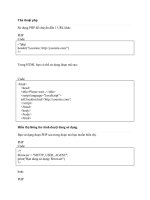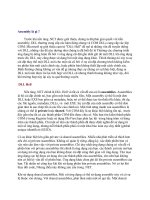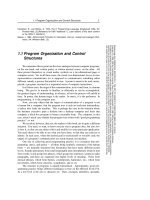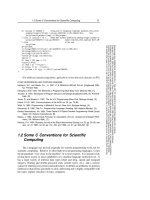Tài liệu Eigensystems part 4 doc
Bạn đang xem bản rút gọn của tài liệu. Xem và tải ngay bản đầy đủ của tài liệu tại đây (176.49 KB, 7 trang )
11.3 Eigenvalues and Eigenvectors of a Tridiagonal Matrix
475
Sample page from NUMERICAL RECIPES IN C: THE ART OF SCIENTIFIC COMPUTING (ISBN 0-521-43108-5)
Copyright (C) 1988-1992 by Cambridge University Press.Programs Copyright (C) 1988-1992 by Numerical Recipes Software.
Permission is granted for internet users to make one paper copy for their own personal use. Further reproduction, or any copying of machine-
readable files (including this one) to any servercomputer, is strictly prohibited. To order Numerical Recipes books,diskettes, or CDROMs
visit website or call 1-800-872-7423 (North America only),or send email to (outside North America).
f += e[j]*a[i][j];
}
hh=f/(h+h); Form K, equation (11.2.11).
for (j=1;j<=l;j++) { Form q and store in e overwriting p.
f=a[i][j];
e[j]=g=e[j]-hh*f;
for (k=1;k<=j;k++) Reduce a, equation (11.2.13).
a[j][k] -= (f*e[k]+g*a[i][k]);
}
}
} else
e[i]=a[i][l];
d[i]=h;
}
/* Next statement can be omitted if eigenvectors not wanted */
d[1]=0.0;
e[1]=0.0;
/* Contents of this loop can be omitted if eigenvectors not
wanted except for statement d[i]=a[i][i]; */
for (i=1;i<=n;i++) { Begin accumulation of transformation ma-
trices.l=i-1;
if (d[i]) { This block skipped when i=1.
for (j=1;j<=l;j++) {
g=0.0;
for (k=1;k<=l;k++) Use u and u/H stored in a to form P·Q.
g += a[i][k]*a[k][j];
for (k=1;k<=l;k++)
a[k][j] -= g*a[k][i];
}
}
d[i]=a[i][i]; This statement remains.
a[i][i]=1.0; Reset row and column of a to identity
matrix for next iteration.for (j=1;j<=l;j++) a[j][i]=a[i][j]=0.0;
}
}
CITED REFERENCES AND FURTHER READING:
Golub, G.H., and Van Loan, C.F. 1989,
Matrix Computations
, 2nd ed. (Baltimore: Johns Hopkins
University Press),
§
5.1. [1]
Smith, B.T., et al. 1976,
Matrix Eigensystem Routines — EISPACK Guide
, 2nd ed., vol. 6 of
Lecture Notes in Computer Science (New York: Springer-Verlag).
Wilkinson, J.H., and Reinsch, C. 1971,
Linear Algebra
,vol.IIof
Handbook for Automatic Com-
putation
(New York: Springer-Verlag). [2]
11.3 Eigenvalues and Eigenvectors of a
Tridiagonal Matrix
Evaluation of the Characteristic Polynomial
Once our original, real, symmetric matrix has been reduced to tridiagonal form,
one possible way to determine its eigenvalues is to find the roots of the characteristic
polynomial p
n
(λ) directly. The characteristic polynomial of a tridiagonal matrix can
be evaluated for any trial value of λ by an efficient recursion relation (see
[1]
,for
example). The polynomials of lower degree produced during the recurrence form a
476
Chapter 11. Eigensystems
Sample page from NUMERICAL RECIPES IN C: THE ART OF SCIENTIFIC COMPUTING (ISBN 0-521-43108-5)
Copyright (C) 1988-1992 by Cambridge University Press.Programs Copyright (C) 1988-1992 by Numerical Recipes Software.
Permission is granted for internet users to make one paper copy for their own personal use. Further reproduction, or any copying of machine-
readable files (including this one) to any servercomputer, is strictly prohibited. To order Numerical Recipes books,diskettes, or CDROMs
visit website or call 1-800-872-7423 (North America only),or send email to (outside North America).
Sturmian sequence that can be used to localize the eigenvalues to intervals on the
real axis. A root-finding method such as bisection or Newton’s method can then
be employed to refine the intervals. The corresponding eigenvectors can then be
found by inverse iteration (see §11.7).
Procedures based on these ideas can be found in
[2,3]
. If, however, more
than a small fraction of all the eigenvalues and eigenvectors are required, then the
factorization method next considered is much more efficient.
The QR and QL Algorithms
The basic idea behind the QR algorithm is that any real matrix can be
decomposed in the form
A = Q · R (11.3.1)
where Q is orthogonal and R is upper triangular. For a general matrix, the
decomposition is constructed by applying Householder transformations to annihilate
successive columns of A below the diagonal (see §2.10).
Now consider the matrix formed by writing the factors in (11.3.1) in the
opposite order:
A
= R · Q (11.3.2)
Since Q is orthogonal, equation (11.3.1) gives R = Q
T
· A. Thus equation (11.3.2)
becomes
A
= Q
T
· A · Q (11.3.3)
We see that A
is an orthogonal transformation of A.
You can verify that a QR transformation preserves the following properties of
a matrix: symmetry, tridiagonal form, and Hessenberg form (to be defined in §11.5).
There is nothing special about choosing one of the factors of A to be upper
triangular; one could equally well make it lower triangular. This is called the QL
algorithm, since
A = Q · L (11.3.4)
where L is lower triangular. (The standard, but confusing, nomenclature R and L
stands for whether the right or left of the matrix is nonzero.)
Recall that in the Householder reduction to tridiagonalform in §11.2, we started
in the nth (last) column of the original matrix. To minimize roundoff, we then
exhorted you to put the biggest elements of the matrix in the lower right-hand
corner, if you can. If we now wish to diagonalize the resulting tridiagonal matrix,
the QL algorithm will have smaller roundoff than the QR algorithm, so we shall
use QL henceforth.
11.3 Eigenvalues and Eigenvectors of a Tridiagonal Matrix
477
Sample page from NUMERICAL RECIPES IN C: THE ART OF SCIENTIFIC COMPUTING (ISBN 0-521-43108-5)
Copyright (C) 1988-1992 by Cambridge University Press.Programs Copyright (C) 1988-1992 by Numerical Recipes Software.
Permission is granted for internet users to make one paper copy for their own personal use. Further reproduction, or any copying of machine-
readable files (including this one) to any servercomputer, is strictly prohibited. To order Numerical Recipes books,diskettes, or CDROMs
visit website or call 1-800-872-7423 (North America only),or send email to (outside North America).
The QL algorithm consists of a sequence of orthogonal transformations:
A
s
= Q
s
· L
s
A
s+1
= L
s
· Q
s
(= Q
T
s
· A
s
· Q
s
)
(11.3.5)
The following (nonobvious!) theorem is the basis of the algorithm for a general
matrix A:(i)IfAhas eigenvalues of different absolute value |λ
i
|,then A
s
→[lower
triangular form] as s →∞. The eigenvalues appear on the diagonal in increasing
order of absolute magnitude. (ii) If A has an eigenvalue |λ
i
| of multiplicity p,
A
s
→ [lower triangular form] as s →∞, except for a diagonal block matrix
of order p, whose eigenvalues → λ
i
. The proof of this theorem is fairly lengthy;
see, for example,
[4]
.
The workload in the QL algorithm is O(n
3
) per iteration for a general matrix,
which is prohibitive. However, the workload is only O(n) per iteration for a
tridiagonal matrix and O(n
2
) for a Hessenberg matrix, which makes it highly
efficient on these forms.
In this section we are concerned only with the case where A is a real, symmetric,
tridiagonal matrix. All the eigenvalues λ
i
are thus real. According to the theorem,
if any λ
i
has a multiplicity p, then there must be at least p − 1 zeros on the
sub- and superdiagonal. Thus the matrix can be split into submatrices that can be
diagonalized separately, and the complication of diagonal blocks that can arise in
the general case is irrelevant.
In the proof of the theorem quoted above, one finds that in general a super-
diagonal element converges to zero like
a
(s)
ij
∼
λ
i
λ
j
s
(11.3.6)
Although λ
i
<λ
j
, convergence can be slow if λ
i
is close to λ
j
. Convergence can
be accelerated by the technique of shifting:Ifkis any constant, then A − k1 has
eigenvalues λ
i
− k. If we decompose
A
s
− k
s
1 = Q
s
· L
s
(11.3.7)
so that
A
s+1
= L
s
· Q
s
+ k
s
1
= Q
T
s
· A
s
· Q
s
(11.3.8)
then the convergence is determined by the ratio
λ
i
− k
s
λ
j
− k
s
(11.3.9)
The idea is to choose the shift k
s
at each stage to maximize the rate of
convergence. A good choice for the shift initially would be k
s
close to λ
1
,the
smallest eigenvalue. Then the first row of off-diagonal elements would tend rapidly
to zero. However, λ
1
is not usually known apriori. A very effective strategy in
practice (although there is no proof that it is optimal) is to compute the eigenvalues
478
Chapter 11. Eigensystems
Sample page from NUMERICAL RECIPES IN C: THE ART OF SCIENTIFIC COMPUTING (ISBN 0-521-43108-5)
Copyright (C) 1988-1992 by Cambridge University Press.Programs Copyright (C) 1988-1992 by Numerical Recipes Software.
Permission is granted for internet users to make one paper copy for their own personal use. Further reproduction, or any copying of machine-
readable files (including this one) to any servercomputer, is strictly prohibited. To order Numerical Recipes books,diskettes, or CDROMs
visit website or call 1-800-872-7423 (North America only),or send email to (outside North America).
of the leading 2 × 2 diagonal submatrix of A.Thensetk
s
equal to the eigenvalue
closer to a
11
.
More generally, suppose you have already found r − 1 eigenvalues of A.Then
you can deflate the matrix by crossing out the first r − 1 rows and columns, leaving
A =
0 ··· ··· 0
···
0
.
.
. d
r
e
r
.
.
.
.
.
. e
r
d
r+1
··· 0
d
n−1
e
n−1
0 ··· 0 e
n−1
d
n
(11.3.10)
Choose k
s
equal to the eigenvalue of the leading 2 × 2 submatrix that is closer to d
r
.
One can show that the convergence of the algorithm with this strategy is generally
cubic (and at worst quadratic for degenerate eigenvalues). This rapid convergence
is what makes the algorithm so attractive.
Note that with shifting, the eigenvalues no longer necessarily appear on the
diagonal in order of increasing absolute magnitude. The routine eigsrt (§11.1)
can be used if required.
As we mentioned earlier, the QL decomposition of a general matrix is effected
by asequenceofHouseholder transformations. For atridiagonalmatrix,however, it is
moreefficient touseplanerotationsP
pq
. Oneusesthe sequence P
12
, P
23
,...,P
n−1,n
to annihilate the elements a
12
,a
23
,...,a
n−1,n
. By symmetry, the subdiagonal
elements a
21
,a
32
,...,a
n,n−1
will be annihilated too. Thus each Q
s
is a product
of plane rotations:
Q
T
s
= P
(s)
1
· P
(s)
2
···P
(s)
n−1
(11.3.11)
where P
i
annihilates a
i,i+1
. Note that it is Q
T
in equation (11.3.11), not Q, because
we defined L = Q
T
· A.
QL Algorithm with Implicit Shifts
The algorithm as described so far can be very successful. However, when
the elements of A differ widely in order of magnitude, subtracting a large k
s
from the diagonal elements can lead to loss of accuracy for the small eigenvalues.
This difficulty is avoided by the QL algorithm with implicit shifts. The implicit
QL algorithm is mathematically equivalent to the original QL algorithm, but the
computation does not require k
s
1 to be actually subtracted from A.
The algorithm is based on the following lemma: If A is a symmetric nonsingular matrix
and B = Q
T
· A · Q,whereQis orthogonal and B is tridiagonal with positive off-diagonal
elements, then Q and B are fully determined when the last row of Q
T
is specified. Proof:
Let q
T
i
denote the ith row vector of the matrix Q
T
.Thenq
i
is the ith column vector of the
11.3 Eigenvalues and Eigenvectors of a Tridiagonal Matrix
479
Sample page from NUMERICAL RECIPES IN C: THE ART OF SCIENTIFIC COMPUTING (ISBN 0-521-43108-5)
Copyright (C) 1988-1992 by Cambridge University Press.Programs Copyright (C) 1988-1992 by Numerical Recipes Software.
Permission is granted for internet users to make one paper copy for their own personal use. Further reproduction, or any copying of machine-
readable files (including this one) to any servercomputer, is strictly prohibited. To order Numerical Recipes books,diskettes, or CDROMs
visit website or call 1-800-872-7423 (North America only),or send email to (outside North America).
matrix Q. The relation B · Q
T
= Q
T
· A can be written
β
1
γ
1
α
2
β
2
γ
2
.
.
.
α
n−1
β
n−1
γ
n−1
α
n
β
n
·
q
T
1
q
T
2
.
.
.
q
T
n−1
q
T
n
=
q
T
1
q
T
2
.
.
.
q
T
n−1
q
T
n
· A (11.3.12)
The nth row of this matrix equation is
α
n
q
T
n−1
+ β
n
q
T
n
= q
T
n
· A (11.3.13)
Since Q is orthogonal,
q
T
n
· q
m
= δ
nm
(11.3.14)
Thus if we postmultiply equation (11.3.13) by q
n
,wefind
β
n
=q
T
n
·A·q
n
(11.3.15)
which is known since q
n
is known. Then equation (11.3.13) gives
α
n
q
T
n−1
= z
T
n−1
(11.3.16)
where
z
T
n−1
≡ q
T
n
· A − β
n
q
T
n
(11.3.17)
is known. Therefore
α
2
n
= z
T
n−1
z
n−1
, (11.3.18)
or
α
n
= |z
n−1
| (11.3.19)
and
q
T
n−1
= z
T
n−1
/α
n
(11.3.20)
(where α
n
is nonzero by hypothesis). Similarly, one can show by induction that if we know
q
n
,q
n−1
,...,q
n−j
and the α’s, β’s, and γ’s up to level n − j, one can determine the
quantities at level n − (j +1).
To apply the lemma in practice, suppose one can somehow find a tridiagonal matrix
A
s+1
such that
A
s+1
= Q
T
s
· A
s
· Q
s
(11.3.21)
where
Q
T
s
is orthogonal and has the same last row as Q
T
s
in the original QL algorithm.
Then
Q
s
= Q
s
and A
s+1
= A
s+1
.
Now, in the original algorithm, from equation (11.3.11) we see that the last row of Q
T
s
is the same as the last row of P
(s)
n−1
. But recall that P
(s)
n−1
is a plane rotation designed to
annihilate the (n − 1,n) element of A
s
− k
s
1. A simple calculation using the expression
(11.1.1) shows that it has parameters
c =
d
n
− k
s
e
2
n
+(d
n
−k
s
)
2
,s=
−e
n−1
e
2
n
+(d
n
−k
s
)
2
(11.3.22)
The matrix P
(s)
n−1
· A
s
· P
(s)T
n−1
is tridiagonal with 2 extra elements:
···
×××
×××x
×××
x ××
(11.3.23)
We must now reduce this to tridiagonal form with an orthogonal matrix whose last row is
[0, 0,...,0,1] so that the last row of
Q
T
s
will stay equal to P
(s)
n−1
. This can be done by









